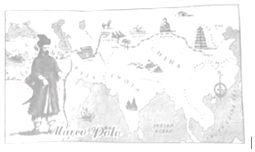For years, it has been said that newspapers are at death's door.Every year brings more news of closing.But why is the situation so terrible for newspapers?
Newspapers have a long history. The first newspaper was printed in the 1600s. Their most successful period is in the early 20th century.
With the appearance of radio and TV, however, newspaper circulation (发行量) began to fall.(3)By the mid﹣20th century,radio and TV had become so popular that people no longer had to depend on newspapers for news. That was especially true for breaking (突发的) news.
Afternoon newspapers were the first to suffer (受损害). After work, more and more people turned on TV instead of opening a newspaper. That was because TV could provide news happening a short time ago. It's true that newspapers couldn't compete with TV on speed, but they could provide in﹣depth (深入详尽的) reports that TV news could not.
But newspapers suffered another, heavier blow (打击) in the 1990s. With the appearance of the Internet, tons of information became free. Many newspaper readers realized that they could read news on the Internet. There seemed to be little reason to pay for a newspaper subscription (订阅).
So what does the future hold? Will newspapers die? Maybe not. Many newspapers are now making changes. Some are going digital (数字的). Some are going farther and taking the industry to places it has never been to. After all, people still want the news. And many agree that newspapers are still an important source (来源) of in﹣depth news, analysis (分析) and opinions.
(4)If newspapers disappear completely.there will be nothing to take their place.
A.根据短文内容简要回答问题.
(1)What made the newspaper circulation fall?
(2)Will newspapers disappear? Why or why not?(选择一种情况作答)
B.将短文中划线的句子译成汉语.
(3)
(4)
C.请给短文拟一个适当的英文标题.
(5)
A tornado (龙卷风) is a kind of strong storm with air which moves in a circle quickly. They can move over 200 miles per hour and cause a lot of damage (损坏). As they move across the land, they can easily pick up cars, trucks, and even houses, and then throw them very far. It is important to find a safe place if a tornado gets close.
A safe place could be a basement (地下室) or the lowest floor. If you are in a home without a basement, try to find a first﹣floor bathroom or a small room without windows in the middle of your house. You should curl up (蜷缩) into a ball and cover your head and neck with your hands.
But there are some people who actually want to get close to tornadoes. They are scientists who want to learn more about tornadoes. One of the best ways to do this is to get as close as possible to the tornado. They use special tools to measure (测量) what is happening in and around a tornado.
One special tool is called a tornado probe (探测仪). Inside the tornado probe, there are sensors (传感器) to measure wind speed, temperature,pressure,and direction.Some probes even have cameras, so the scientists can see and understand what it's like to be in a tornado.
To be able to get these measurements,the scientists have to get a tornado probe near or into a tornado.Scientists will try to guess where a tornado will go next. Then they drive to that location and put down the probe. If they do not guess correctly, they pick up their probe and try another place.If they are right,the tornado will go near or even right over the probe. Then they take all of the measurements from the probe and use them to predict where future tornadoes may form (形成)and travel. And they can give people some warning to keep away from a dangerous tornado.
(1)If a tornado gets close, what should people do to keep safe?
A. Go to a basement.
B. Find a small room.
C. Stay in a bathroom.
D. Curl the legs up.
(2)What can the sensor in a probe NOT do?
A. Measure wind speed and temperature.
B. Take photos and videos.
C. Measure wind temperature and pressure.
D. Measure wind speed and direction.
(3)Which statement about the scientists is TRUE?
A. They risk their lives studying tornadoes.
B. They can easily put the probe in the right place.
C. They get close to a tormado to admire it.
D. With the help of the measurements, they can prevent the tornado forming.
(4)The passage mainly tells us .
A. what a tornado is
B. how dangerous a tornado is
C. where a tornado may form and travel
D. how scientists do research work on tornadoes
(5)You may find this passage in .
A. a novel
B. a storybook
C. a guidebook
D. a science magazine
The opening of the Beijing﹣Zhangjiakou high﹣speed railway took place in December,2019. The railway is a milestone in China's railway development because it has used the latest technologies in railway building.
The railway is 174 kilometers long, with 10 stations. The stations are managed by one control center, which is described by China Railway Beijing Group一also known as CR Beijing﹣ as an "intelligent(智能的) brain". The center collects and shares the stations' real﹣time information. " With the information, the workers in the center can control the stations' lighting and temperature, monitor(监 测) trains' operation and deal with emergencies(紧急情况)."said Zhu Dianping. from CR Beijing.
Zhu said some trains on the Beijing﹣ Zhangjiakou line are"smart" as they provide 5G signals and wireless charging( 无线充电)for passengers, as well as intelligent lighting.These trains can start and stop, open and close doors, and deal with emergencies themselves.
All the ten stations provide ﹣ticket services, Travelers who have bought tickets online can use their ID cards instead of waiting in line for paper tickets.
At Qinghe Railway Station in Beijing, China's first visual remote ticket vending machine(远程可视售票机) has been installed(安装) to help passengers who are not able to afford tickets online Passengers keep in touch with the conductor through the machine and buy tickets according to video instructions.
In addition, the Badaling Great Wall Station, the deepest underground railway station in Chin, is another great example of the country s achievements in railway building.
(1)What does the word "milestone" mean in Chinese?
A.英石(重量单位)
B.垫脚石
C.里程碑
D.里程表
(2)The control center is described as .
A. CR Beijing
B. Railway Beijing Group
C. a railway station
D. an "intelligent brain"
(3)Which is right according to the passage?
A. Each station has a control center.
B. All the trains can start and stop themselves.
C. All the stations have visual remote ticket vending machines.
D. The Badaling Great Wall Station is the deepest underground railway station in China.
(4)E﹣ticket services are provided so that travelers .
A. can buy cheaper tickets
B. needn't wait in line for paper tickets
C. can only buy tickets online
D. can buy paper tickets
(5)What is special about the Beijing﹣ Zhangjiakou high﹣speed railway according to the passage?
A. Fast and cheap.
B. Long and deep.
C. Smart and intelligent.
D. Expensive and steady.
|
|
Victoria Amazonica |
The Victoria Amazonica is native to(原产于)South America.It is famous for its size and strength. Its huge leaves grow to 2.5m in diameter(直径), and a fully﹣grown leaf can support a little kid sitting in the center. Its flowers are also big ﹣ up to 40cm in diameter. However, you can only enjoy the sight of the flowers for a short time, because they last for only 48 hours or so. |
Calceolaria Uniflora |
The Calceolaria Uniflora is a plant from the southern area of South America.It looks like a slipper(拖鞋). It is also known as Darwin's Slipper Flower, because it was first discovered by Charles Darwin in his trip around South America. These amusing flowers also look like little orange aliens walking together over the rocks, so sometimes they are nicknamed the Happy Alien Plant. |
Azorella Compacta |
The Azorella Compacta looks like a beanbag sofa,but actually it is made up of thousands of flowering buds(花蕾)on long stems(茎).It can support the weight of a human.The plant is native to the high Andes in South America.It grows very slowly,nearly 15mm per year. It is also one of the oldest living things in the world. Many of the Azorella Compactas we see are thought to be over 3,000 years old. |
回答下面 5 个问题,每题答案不超过7个词
(1)How long is the Victoria Amazonica in flower?
(2)There are another two names for the Calceolaria Uniflora. What are they?
(3)How fast does the Azorella Compacta grow?
(4)Are the Victoria Amazonica and the Azorella Compacta weak or strong?
(5)Please give a suitable title for the article.
Antarctica (南极洲) is at the southern end of the Earth. It is the coldest, driest and windiest place on our planet. What would it be like to live and work there?
On Oct 15, 50 Chinese researchers took a ship named Xuelong 2 from Shenzhen to Antarctica. Xuelong 2 is the first icebreaker (破冰船) made in China. It took two years to build Xuelong 2. It is reported that Xuelong 2 is one of the world's best research icebreakers.
Chinese researchers have been to Antarctica 35 times. Because of its unusual environment, researchers from around the world have been going there to do study (研究) for many years. Some studies can only be done in Antarctica. For example, there is little air pollution there. This makes it easier for scientists to study the weather, atmosphere (大气) and stars.
The study of Antarctica's geology (地质) is also important. Rocks in Antarctica can tell us what the weather was like long time ago, and help us understand how the Earth has changed over time. There are also many wild animals, such as penguins (企鹅),seals (海豹) and birds. Scientists can learn how animals live in cold places by studying them.
Xie Zhouqing is a professor at the University of Science and Technology of China. He was part of China's 15th research trip to Antarctica. He said, "Life in Antarctica is not easy.It is tiring and sometimes dangerous, but it is still quite fun." He also said,"I studied how penguins walk, what they eat, and why they move from one place to another. I was excited to see the cute animals playing around. I hope my studies can help protect them."
(1)What can we know from the first three paragraphs?
A. Antarctica is at the northern end of the Earth.
B. There is plenty of air pollution in Antarctica.
C. Xuelong 2 is the first icebreaker made in China.
D. Chinese scientists have been to Antarctica 45 times.
(2)What does the underlined word "it" mean in the fifth paragraph?
A. Life in Antarctica.
B. Rocks in Antarctica.
C. Fun in Antarctica.
D. Danger in Antarctica.
(3)What can we infer (推断) from the passage?
A. The weather in Antarctica hasn't changed over time.
B. Xie Zhouqing mainly studied geology in Antarctica.
C. Chinese researchers have done many studies in Antarctica.
D. The study in Antarctica can't help protect penguins and seals.
(4)Where does the passage probably come from?
A. A storybook.
B. A cooking guide.
C. A film review.
D. A science magazine.

I come from Cambridge, a beautiful city in the coast of England. It is on the River Cam and has a population of about 120, 000. My home town is especially famous for its university. Many famous people studied here, such as Isaac Newton and Charles Darwin. There are lots of old buildings and churches to visit. Students and tourists enjoy trips along the river by boat.
Cambridge is 80 kilometers from London. London is in the south of England and it is on the River Thames. It has a population of about seven and a half million, so it is bigger and busier than Cambridge. It is about 2, 000 years old, and it is famous for Big Ben, Buckingham Palace and Tower Bridge.
England itself is part of an island, and you are always near the sea. The small villages and beaches on the coast are popular for holidays. Tourists like the areas of low mountains and beautiful lakes in the north, and the hills and pretty villages in the south. Everywhere in England, you will notice how green the countryside is.
It is never very hot in summer or very cold in winter. So come and see England any time of the year, but bring an umbrella with you. It rains a lot all year round. You will need it most days.
(1)Cambridge is .
A.in the coast of England
B.in the south of England
C.on the River Thames
D.far from the River Cam
(2)How many examples of famous people are mentioned in the passage?
A.One.
B.Two.
C.Three.
D.Four.
(3)What can we know about Cambridge and London?
A.Cambridge is much busier than London.
B.London is 2, 000 kilometers from Cambridge.
C.Cambridge has more famous buildings than London.
D.London has a much bigger population than Cambridge.
(4)Tourists like in the south of England.
A. the churches
B.the low mountains
C.the pretty village
D.the beautiful lakes
(5)It is in England.
A.very hot in summer
B.very cold in winter
C. not very cold in winter
D.not rainy all year round
Egypt is one of the oldest civilizations (文明) in the world. It has great culture and history. Let's take a look at some wonderful places in the country.
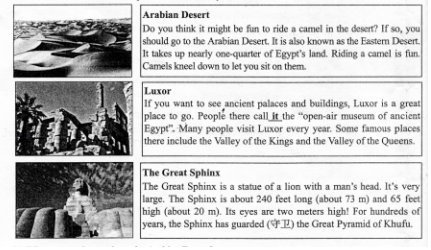
(1)What can we know about the Arabian Desert?
A. It is the third largest desert in the world.
B. It takes up nearly one﹣quarter of Egypt's land.
C. It is located in Western Africa.
D. It is famous for its large number of camels.
(2)What does the underlined word "it" refer to in this passage?
A. Dessert
B. Egypt.
C. Valley.
D. Luxor.
(3)Which of the following places is NOT in Egypt?
A. Luxor.
B. The Valley of the Kings.
C. The Valley of the Queens.
D. Kilimanjaro.
(4) guards the Great Pyramid of Khufu.
A. The Eastern Desert
B. The Great Sphinx
C. The Nile River
D. The Arabian Desert
(5)This passage is mainly about .
A. the history of Africa
B. famous pyramids in Egypt
C. famous places in Egypt
D. the largest country in Africa
Writing is a much newer invention than talking. Nobody knows when people first began to talk, but so far as we know, they did not begin to write until seven or eight thousand years ago.
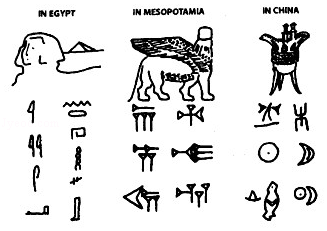
In Egypt, Mesopotamia, and China, and later in Palestine and Greece, people began to make marks and pictures with sticks and sharp stones from which others, or they themselves
later, could see what they had thought.
These early records were the beginning of writing.The first writing was picture writing.Here are some early Chinese picture words. Can you see what they represent (代表)?

Later Chinese writing is less like pictures than the earlier writing was, but we can see the pictures in some of its words. For example:

In picture writing, each picture represents a word; you need a different picture or mark for each word.
In present﹣day Chinese writing most of the marks are not pictures of anything, and a reader has to learn how the Chinese write about two thousand of these words before being able to read a newspaper.
With some of these marks you may be able to see what the idea is, For example:
The sun and the moon.明Its meanings are:"bright" and" open".
A man and two marks.仁One of the meanings is "humanity".
(1)When did people begin to write?
A.Seven or eight hundred years ago.
B. Before people first began to talk.
C. Seven or eight thousand years ago.
(2)Which of the following is the earliest Chinese picture word?
A.
B.
C.雨
(3)What does the明in the passage mean?
A.Day and night.
B.Bright and open.
C. Humanity.
(4)What's the passage mainly about?
A. The history of Chinese writing.
B.When Chinese people began to write.
C. How the Chinese began to talk.

In many places the weather changes during the year. These changes are called seasons. In the north and south there are four seasons in a year. At the North and South Pole, there are only two seasons. In tropical(热带) places near the Earths equator( 赤道). there are two seasons a wet season and a dry season. Each season brings changes. They are important for plants and animals that live in different parts of the world.
Spring starts when the day and night are the same length. The weather gets warmer and sunnier. Trees and plants start to grow. Many animals have their babies in spring.
Summer begins on the longest day of the year. In the north this is on June 21 or 22. Summer is usually the warmest and sunniest time of the year. Fruit grows faster on trees and plants. Young animals grow bigger and stronger.
Autumn starts when the day and night are the same length again. During autumn, the leaves change color and fall down from the trees. Some animals collect food before winter comes.
Winter begins on the shortest day of the year. In the north this is on December 21 or 22. The weather is colder and in some places there is lots of snow. Plants and trees stop growing. Some animals, like bats and bears, find places to hide and sleep. This is called hibernation.
(1)There are seasons on Greenland(格陵兰岛) at the North pole.
A.four
B. three
C. two
D.one
(2)Many animals in spring.
A. have babies
B. change color
C. collect food
D. stop growing
(3)Fruit grows faster on trees and plants in .
A. Spring.
B. Summer.
C. Autumn.
D. Winter.
(4)The meaning of the underlined word "hibernation"is in Chinese
A.迁徒
B.寒冷
C.储藏
D.冬眠
(5) start when the day and night are the same length.
A.Spring and summer
B. Summer and autumn
C. Autumn and winter
D. Spring and autumn
Thanks to the ancient Silk Road, the lands of Italy and China have been connected for more than 2,000 years. Tourists from China and every corner of the world come to visit Italy every year. Here are four famous cities of Italy.
Rome Coliseum |
Rome is the birth place of science, culture and of course, art in Europe. It is the perfect combination(结合)of the modern and the classical. When one walks around the city, one can see many museums. Of course, Rome is also considered as the fashion(时尚)centre of the world now. The Rome Coliseum is today considered one wonder(奇迹)of the modern world. |
Pisa is a small city. It is famous for the leaning tower of Pisa. If you think that Pisa has only one leaning tower, you may just be wrong. This city has three leaning towers. Home of the famous scientist Galileo, Pisa is also known for its universities because the city is home of some of the most important universities in Europe. |
Leaning Tower |
David |
Florence is one of the most important provinces around Italy. Shopping here, you'll find David, the most famous statue(雕像)of Michelangelo. If you are planning to spend a couple of days in Florence, you likely will not want to lose the opportunity to see and enjoy Arnolfo Tower, it will be open on Sunday and Monday from 9 am to 6 pm.(closed in case of rain). |
Venice is a city over a hundred islands. You can visit most interesting places of the city by walks or by the famous gondolas. Art exhibitions, film festivals and famous carnival(狂欢节)make Venice a place that can be visited any time of the year. |
|
(1)According to the passage, is considered as a fashion center of the world now.
A. Rome
B. Pisa
C. Florence
D. Venice
(2)Pisa is also famous for its besides leaning towers.
A. universities
B. art exhibitions
C. film festivals
D. museums
(3)We can visit Arnolfo Tower .
A. at 8 am on Sunday
B. at 9 am on Tuesday
C. at 9 pm on Saturday
D. at 10 am on Monday
(4)According to the passage, which one of the following is NOT true?
A. Pisa has three leaning towers.
B. You'll find David when you go shopping in Florence.
C. You can visit most interesting places of Venice by walks or by bus.
D. Every year, thousands of tourists all over the world come to visit Italy.
(5)What is the best title of the passage?
A. Italy and China.
B. The ancient Silk Road.
C. All roads lead to Rome.
D. Four famous cities of Italy.
There are long rivers, and there are famous rivers. The Nile(尼罗河)is the world's longest and most famous river. It runs 6,650 kilometers. Crocodiles and hippos(河马)live in its waters. Pyramids built by ancient Egyptians rise along its banks.
The main branch of the Nile, the White Nile, starts just above Lake Victoria, the world's second largest fresh﹣water lake, in east central Africa. Then it flows to the north. At Sudan's capital, another great river called the Blue Nile joins the White Nile. Together, they form one very powerful river. Then it goes through Egypt's famous Nile Valley before reaching the Mediterranean Sea.
Ancient Egypt, the first great African civilization(文明), started along the banks of the Nile more than 5,000 years ago. Ancient Egypt ruled the Nile Valley for thousands of years. Great pyramids and temples were built on the banks and we can still visit them today.
Without the rich farmland along the banks of the Nile, there might be no ancient Egypt civilization. Every year, the Nile flooded its banks. The floodwaters covered the banks with a rich soil. The Nile's banks were easy to farm and produce crops.
The Nile also made a perfect highway for boats. The river runs north, but the wind on the river blows south. To go south, boaters put up sails to catch the wind. To go north, they took the sails down. Ancient people traded along the river for hundreds of miles.
The Nile ﹣ the (1) and most famous river in the world |
|
Where does the Nile flow? |
• The White Nile is the (2) ___ branch of the Nile. It starts (3) ____ Lake Victoria and then runs to the north. • The Blue Nile joins the White Nile at the (4) __ of Sudan. They form a powerful river. • Then the Nile goes through the Nile Valley. Finally it (5) ___ the Mediterranean Sea. |
The Nile's long and rich (6) . |
• Ancient Egypt started along the banks of the Nile over 5.000 years ago. Its people (7) ___ pyramids and temples we can still visit today. • Every year the Nile flooded its banks. The floodwaters covered the banks with a rich soil. Rich farmland made this ancient civilization(8) . • The Nile made a perfect highway for boats. To go south, boaters put up sails to catch the wind. To go (9) , they took the sails down. Ancient people bought and (10) ___ goods along the river for hundreds of miles. |
Which sentence should be put at the end of the paragraph on the right? ( )
I like to see the mountains. There are some small mountains and some tall mountains. The small mountains are green and have lots of trees.________ |
A.The mountains are tall.
B.The mountains are tall and nice.
C.The nice mountains are interesting to look at.
D.The tall mountains are covered with white snow.
The Dead Sea
At 430 meters below sea level, the Dead Sea is Earth's lowest point on land. It is popular for its wonderful buoyancy(浮力). The high salt content﹣more than 34 percent ﹣ makes swimming more like floating.
Now the Dead Sea is actually dying. People are using water from the Jordan River, which takes water away from the Dead Sea. Since 1930, its surf area has reduced by almost 40 percent.
Venice, Italy
With waterways instead of streets. This "Floating City" has attracted visitors for centuries. But no visit to Venice is complete without a ride on one of its famous gondolas, human powered water taxis. Water creates Venice. But water will also kill the city.
Built on soft earth, Venice has slowly been sinking (下沉) for centuries. Now, with rising sea levels caused by human activities, it's sinking faster. According to US﹣based magazine Architectural Digest, the city may disappear in the next 100 years. Better book your gondola soon!
Great Barrier Reef, Australia
Covering more than 2,300 kilometers of Australia's northeast coast, Great Barrier Reef is the world's largest reef ecosystem, and an ideal place for scuba divers (水肺潜水者).Thousands of colorful coral (珊瑚) and fish make homes in the blue sea water. It's like a big underwater party!
Sadly, the party might be over soon. The reef is dying. Human activities are changing the weather. Warming ocean, water kills the coral, and this causes problems up the food chain. The New York Times reported that large parts are already dead, and the reef system might be gone by 2030.
(1)What can be the best title of the passage?
A. Disappearing Watery Wonders
B. Amazing Man﹣made Wonders on the Sea
C. Lost Watery Wonders on the Sea
D. Last Watery Wonders in the World
(2)Which of the following is the shared cause of the problems all the three places are facing?
A. Water loss.
B. Sea pollution.
C. Warming seas.
D. Human activities.
(3)If Tom wants to visit all the following places before they are gone, and he can only afford one in the next 15 years, where must he go?
A. The Dead Sea.
B. Venice.
C. Italy.
D. Great Barrier Reef.
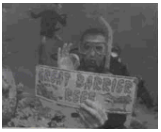
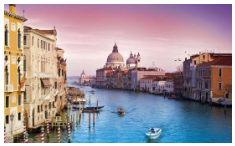

When Zheng He was born, he was named Ma Wenhe. He was born in Yunnan in 1371. (1) However, when the Ming Dynasty was established (建立), the army caught Ma Wenhe and took him to one of the emperor's sons, Prince Zhu Di.
Ma Wenhe served the prince well and soon he became one of the prince's closest advisors. (2) . Later the prince became the Emperor of the Ming Dynasty as the Yongle Emperor. The Yongle Emperor wanted to show other countries the greatness and power of the Ming Dynasty. (3) . He made Zheng He the leader of a fleet (舰队) and ordered him to explore (探索) the world.
On Zheng He's first trip, he traveled all the way to Calicut, India. With over 200ships and nearly 28,000men, he visited many countries along the way. His first trip lasted from 1405to1407. Zheng He and his fleet traded and made close relations at the places they visited.
Zheng He continued to sail for the Ming Dynasty over the rest of his life. He traveled to many faraway places, going all the way to the African coast and establishing trade relations with over 25countries. (4) . He also brought back diplomats (外交官) from many countries to meet with the Chinese Emperor.
A. Some of the ships were longer than a football field. B. The prince trusted him and changed his name to Zheng He. C. His father and grandfather were Muslim leaders of the Yuan Dynasty. D. He brought back all kinds of animals such as giraffes and camels. E. He also wanted to establish trade relations with other peoples of the world. |
Marco Polo was born in Italy in 1254. When he was 17, he travelled along the Silk Road with his father. who wanted to trade with the Chinese. Finally, they arrived in Beijing. They were guests at the Emperor's Palace. Marco was very clever and could speak four languages. The Emperor was impressed by him and they became friends. He asked Marco to serve in his court (宫殿) and sent him to do many important jobs all over the country.
Marco was amazed by how beautiful China was. He was impressed by Beijing and the Emperor's Palace, especially the Summer Palace which was described as "The greatest palace that I've ever seen". The walls were covered with gold and silver and the hall was so big that it could easily hold 6,000 people for dinner."
Marco was also attracted (吸引) by the inventions and developments in China which couldn't be found in Europe at that time. Marco was surprised to see Chinese people using paper money in the markets. In Europe, people paid for goods(货物) with gold and silver. He could not understand how people paid for food and valuable things with paper! He was also puzzled by the black stones people used to burn to produce heat. The black stones were coal, but Marco had never seen coal before!
After he served the Emperor for 17 years, in 1291, Marco returned to Italy. He was a very wealthy man then. A writer wrote down all the stories that Marco told him in a book called The Description of the World, which became one of the best﹣selling books in Europe.
People enjoyed the book, but many of them thought that Marco's stories about China were too fantastic to be true. However, Marco always stood by his tales. Just before he died, aged 70, Marco was asked the question, "Was it all true?" And this was his answer, "I have only told a half what I saw!"
Marco Polo and China |
|
Before arriving in China |
◆ In 1254, he was born in Italy. ◆ At the age of 17, he travelled along the (1) with his father to trade with the Chinese. |
During his living in China |
◆ He made friends with the Emperor and served in the court. ◆ He did many (2) _____around China. |
◆ The beauty of China impressed him. |
|
◆ The (3) _____in China attracted Marco. ①Paper money was used to buy goods in the markets. ②Chinese people used (4) to produce heat. |
|
After returning to Italy |
◆ He became wealthy. ◆ A book written about his traveling experiences around the world sold well in Europe. |
◆ The underlined sentence tells us that (5) . |
|
